Let’s talk...
About the sense of capability as children mimic the movements of various animals. We can talk to our child about tasks they can now accomplish that they couldn’t before. We can also boost their sense of capability by saying, “Yes, you can!”
About play: The book is interactive and encourages movement and play. We can talk with our child about the games they enjoy and introduce them to games we used to enjoy in our childhood.
Let’s enrich our Language...
The book is rich with action verbs and body part names like arms, legs, feet, neck, etc. We can facilitate their use in our daily lives to describe body parts and movements, encouraging the child to describe their actions.
Let’s explore...
We can explore different sources for information about the animals mentioned in the book: their types, food, and living habits. Also, we can enjoy watching a documentary with our child.
Let’s create...
The book employs the well-known collage technique of the illustrator Eric Carle, creating a beautiful composition of cutouts, fabrics, newspapers, and household materials.
Let’s play...
We can play the “Animal Yoga” game together, mimicking the movements of the various animals mentioned in the book, and adding other animals!
نتحادث
قبل فتح الباب: نطلب من الطفل أن يحزر من خلف الباب حسب اللون أو الصورة. نطرق الباب ونفتحه معًا، ثمّ نتأمّل الرسمة ونسأل طفلنا: من خلف الباب؟ ماذا يفعلون؟ نسمّي الشخصيّات والأغراض وما تفعله.
حول المشاعر: نتحدّث مع الطفل عن مشاعر الشخصيّات. مثلاً، يمكن أن نسأله: كيف شعر الأرنب عندما أكل الجزرة؟
حول الرغبات: نسأل طفلنا عن اللون الذي يحبّه، ونبحث معه عن أغراض له نفس اللون.
نثري لغتنا
نستكشف معاني أفعالٍ وردت في الكتاب، مثل: يقرع، يقضم، تفرك، ثم نمثلّها معًا. من الهامّ أن نستخدم هذه الكلمات مع طفلنا في حياتنا اليومية.
نوسّع معارفنا
الألوان: نختار مع طفلنا لونًا من ألوان الأبواب، ونبحث في الغرفة عن أشياء لها نفس اللون ونسمّيها.
نعدّ معًا: نمسك بإصبع طفلنا ونتتبّع الحيوانات في الصفحة ونعدّها. قد نسأله: كم أرنبًا ترى؟ كم قردًا؟ ثمّ كم إصبعًا في كفّة يدك؟ كم عينًا لك؟
نلعب
نقلّد أصوات الحيوانات الظاهرة في الكتاب مثل القرود، أو الأشياء مثل الطبل. نصغي إلى الأصوات المختلفة حولنا، سواء في البيت أو خارجه، نسمّيها ونقلّدها.
حول الكتاب
المربّية العزيزة،
اللقاء الأوّل بين الطفل والكتاب هو خطوة أساسية في تعزيز حبّ الكتاب والقراءة. قبل البدء بسرد القصة، من المهم إتاحة الفرصة للأطفال للتعرف على الكتاب: النظر إلى الغلاف، تصفح الصفحات، والتفاعل مع الصور. هذه المرحلة تساعدهم على تكوين تصورات أولية عمّا سيكتشفونه، ممّا يعزّز انتباههم واستعدادهم للاستماع.
يأخذنا هذا الكتاب في رحلة تفاعلية ممتعة مع الأطفال، حيث يعرّفهم على مفاهيم أساسيّة مثل اللون والعدد، معزِّزًا استيعابهم لها من خلال تفعيل حواسهم المختلفة، مثل: النظر، السمع، واللمس. ويعتمد على لغة بسيطة وسليمة تسهِّل الفهم. إضافةً إلى ذلك، يُثري القاموس اللغوي للأطفال عبر تعريفهم بأسماء الحيوانات، الأدوات، والأفعال الواردة في القصّة، مما يوسّع مفرداتهم ويعمّق معرفتهم بالعالم من حولهم.
نستقبل الكتاب
نستقبل الكتاب معًا:
ضعي صندوق الكتب في وسط الغرفة، واعرضي الكتاب أمام الأطفال، افتحيه وأغلقيه لتوضيح طريقة استخدامه. بعد ذلك، وزّعي الكتب على الأطفال.
نتصفّح الكتاب –
يحتاج الأطفال إلى وقت لاستكشاف الكتاب والتعرف عليه، عن طريق لمسه وتقليبه. دعي الأطفال يلمسون الكتاب، يتصفّحون صفحاته، وينظرون إلى كتب زملائهم. يمكنك طرح أسئلة مثل: “ما هذا؟ ماذا يوجد بالداخل؟”
نقرأ معًا –
نقرأ الكتاب في مجموعات صغيرة في مكان هادئ، ونستمع إلى أغنيته، ثم نعيد القراءة والاستماع مرات عديدة. يساعد تكرار القصة على تعزيز تفاعل الأطفال معها، وترقّبهم للكلمات والصور المألوفة، ممّا يمنحهم شعورًا بالأمان ويعمّق تعلّمهم.
نتحادث
قبل فتح الباب، نطلب من الطفل أن يحزر من خلف الباب حسب اللون أو الصورة. نطرق الباب ونفتحه معًا، ثمّ نتأمّل الرسمة ونسأل الأطفال: من خلف الباب؟ ماذا يفعلون؟ كيف يشعرون؟ نسمّي الأغراض والشخصيّات، وأفعالها ومشاعرها.
موسيقى
موسيقى:
نستمع إلى أغنية الكتاب من خلال مسح الباركود في الغلاف الخلفي للكتاب. وفي كلّ مرّة نتوقّف عند جملة “ندقّ الباب”، وندقّ مع الأطفال على صندوق أو أي سطح قريب، أوّلًا باستخدام اليد، ثم الكوع، ثم القدم. هذا يساعدهم على التفاعل والتعرّف على أجزاء جسمهم، واستكشاف الأصوات المختلفة التي يمكنهم صنعها.
الوعي النغمي
ندقّ كل مرة بإيقاع مختلف: سريع أو بطيء، أو بعدد دقّات مختلف: ندقّ كثيرًا أو ندقّ قليلًا. يمكننا الانتقال إلى التصفيق لجعل النشاط متنوّعًا.
نثري لغتنا
نركّز على إثراء لغة الطفل بالأفعال، عن طريق طرح الأسئلة: ماذا يفعل الأرنب؟ ماذا يفعل نونو الصغير؟ بإمكاننا بعد الإجابة على السؤال أن نُمثّل الفعل معًا.
صندوق المفاجآت
نحضّر صندوقًا نملأُه بأغراض مختلفة، يدقّ كلّ طفل على الصندوق، ثم يمدّ يده ليُخرِج غرضًا ويسمّيه: “سيارة زرقاء!” نستطيع أن نوسّع الجملة عن طريق تكرارها مع إضافة كلمات جديدة، مثلًا: “سيارة زرقاء، سيارة زرقاء سريعة”. تساعد هذه اللعبة على توسيع القاموس اللغويّ وتعزيز بناء الجمل.
نكتشف الألوان
نضع أطباقًا تحتوي على ألوان مختلفة، يغمس كلّ طفل يده في اللون الذي يفضّله ويسمّيه. بعد ذلك، يضع كلّ طفلين كفّيهما معًا ويفركانهما بلطف ليمتزج اللونان، ثم نسأل: ما هو اللون الجديد الذي نتج؟
Let’s talk...
About the Gift: What do you think about “Leo’s” gift? Did you like it, and why? What gift would you want for your birthday? And why?
About writing experience: We can share our memories of moments when we discovered we could write with our child. For example: when we wrote our name for the first time, and when we drew shapes and wrote numbers. We can talk with them about similar experiences they’ve had, and perhaps we can take their hand and writetheir name together.
About animal illustrations: We might ask: Which animal accompanies “Leo”? What other animals are mentioned in the book? What are the commonalities between the children’s world and the animals’ world in the story?
Let’s enrich our language...
Describe pur environment: We can go out with our child to the house yard or balcony, observe a scene, then ask our child to describe it with their eyes closed. We can encourage them to use precise descriptions and actions.
Create a story: our child can tell a story about each drawing, and we can encourage them to express their thoughts and feelings, to enrich their language and build bridges of communication and love between us.
Let’s search for names of animals that belong to the big cat family, like Leo.
Let’s create...
We can dedicate a notebook for writing or drawing family memories. We can enjoy browsing through it from time to time in an enjoyable family session!
Family collage: One family member starts by drawing a shape, and others add lines and shapes to create an amazing collective artwork!
Let’s Talk
- During the first reading, we participate with our child as we follow instructions together. This helps our little one to understand actions through our embodiment and imitation.
- About emotions: we can ask our child how they felt when we read the book and played together, and which books they love and prefer.
- About playing together: we can ask our children which activities and games they like to play together.
Let’s Create
Children learn the art of pointillism and create paintings using this technique. We can use felt-tip pens, cotton swabs, and paint.
Let’s Enrich our Language
- The book is rich in vocabulary and linguistic concepts, touching, pressing, softening, illuminating, and more. We can explain these to our children during reading and use them in daily life.
- We can recall encouraging words from the text and try to use them in our daily lives.
Let’s Play and Have Fun Together
We can play “The King Says:” participants must follow the instructions preceded by the phrase “The King Says.” For example, if we say, “The King says jump to the right,” we jump together. If we say “Jump to the right” only, we don’t jump. We can take turns as a
Let’s Explore
The book presents the art of color blending and mixing. We can mix colors together and learn about new colors.
Read the book...
Read the book together and observe the drawings. Explain to your child the meaning of unknown words, such as carpentry shop, India, lantern.
Chose some words...
Chose some words from the book, such as cup, Summer, cucumber, etc. Encourage the child to think of similar words that rhyme with words from the book. Help the child to construct a sentence that links the two rhyming words.
The child may...
The child may desire to add an additional sentence or more on the book’s last page or to draw some pictures.
"Humanizing" objects...
“Humanizing” objects or animals or attributing feelings to them is part of the fun in rhyming games. Observe the drawings with the child and talk with him/her about what indicates feelings in the drawing (like the happiness of the oil bottle for winning, or sleepiness of the tongue.)
Read together with...
Read the dialogue...
"let's reenact wha...
“Let’s reenact what the hands do!” Change roles by reenacting one of the organs. Acting helps the child in understanding and internalizing the meaning of a verb. This way, the child will reuse the verb to express his/her own experience.
The body organs...
“The body organs tell their own story!” Ask the child to lay down on a big cardboard. Mark the lineout of the entire child’s body. Help the child draw the body details while he/she talks on behalf of the organ about what it has accomplished today. For example, “I am the nose, I smell and breathe.”
Our body organs...
Our body organs work hard for us. So, how do we take care of our organs? Discuss with the child daily care routines of body organs.
Grandmothers and grandfathers...
Grandmothers and grandfathers have a special place in most children’s lives. And the grandparents’ house has its unique smells, tastes, and distinct sights that inhabit the memory of children when they grow up. We can talk with our child about the things they love in their grandparents’ home or in the house of any other person who is close to the family and to our child. Is there a corner in the house that they favor? What do they like to do in their grandparents’ house?
The grandmother in...
The grandmother in the story expresses her concern for her grandson in different ways. We can talk with our child about their interactions with their grandmother or grandfather and how they express their love to each other. For example, preparing a favorite dish, buying small gifts, or telling the grandchildren interesting stories. We can also talk about what we can do to express our concern for our grandmothers and grandfathers.
Do you remember...
Do you remember the hilarious “broken phone” game? The family members sit in a circle, and one of them quickly whispers a word in their neighbor’s ear. The second has to whisper what they heard in the other neighbor’s ear…and so on, until the whispered word reaches the last person in the circle, just to discover that what they heard has nothing to do with the original word!
We can test...
We can test various methods to enhance the delivery of sound to a far location, such as encircling the mouth with both hands, and ways to improve the hearing of sounds, such as tilting the outer ear forward. Are there other methods?
Together, we can...
Together, we can design an amplifier from household items, such as: a cardboard tube, metal foil, or paper cups. We can test a number of amplifiers from different materials and compare them: which sounds best?
If your friend...
If your friend is good as honey, don’t lick him all We can go over the situation without mentioning the idiom, and have a small conversation with our children regarding the child’s desires in the story: are they logical? Can the mother give the child everything he/she wants? We can read the idiom and look at the drawing that describes it: who is the honey in the drawing? What does the drawing tell the child?
The camel limped...
The camel limped because of his lips. Children sometimes try to make any excuse to avoid going to school. It is important to listen carefully to what the child says directly, and try to understand if there is an indirect call of distress because of something the child is going through. We can go over the situation, without reading the idiom, and have a conversation concerning the reasons why the child in the book may not want to go to kindergarten. We can take a look on the camel drawing: does his swallowed lip forbid him to walk?
The pot found...
The pot found its cover. We can talk with our children about the 2 friends in the story: do they love the same games? We can take a look at the drawing and have a conversation about the similarity between the pot and its cover to the two friends in the story. We can have a conversation about our friends who can be a “cover to our pot”: what do we like to do with them?
A hair grew on...
A hair grew on my tongue We can check our tongue: can hair grow on it? Can it grow one day? We can read the situation that talks about the mother who asked her child, several times, to clean up his room: What happened to her tongue as a result of repeating the same sentence? We can imagine different things that might happen to her tongue. We can think together: What can the child and his mother do, so “hair won’t grow on her tongue”?
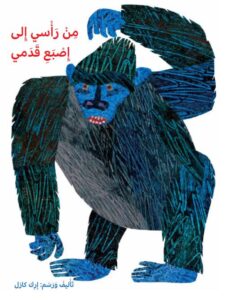 From My Head to My Toe
From My Head to My Toe 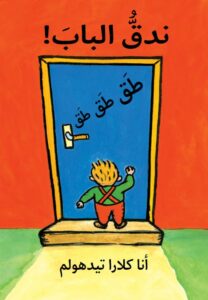 Knocking on the Door – to the Nursery
Knocking on the Door – to the Nursery 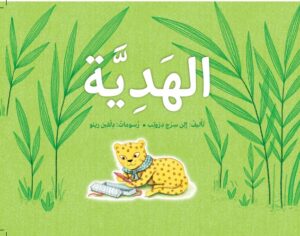 The Gift
The Gift 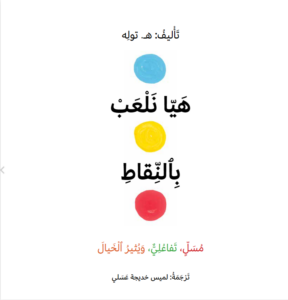 We Play with Dots
We Play with Dots 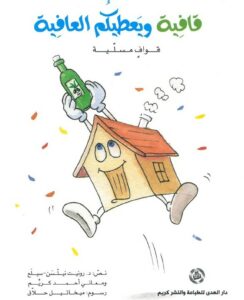 Enjoyable Rhymes
Enjoyable Rhymes 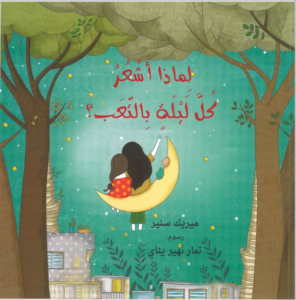 Why Am I Tired At Night?
Why Am I Tired At Night? 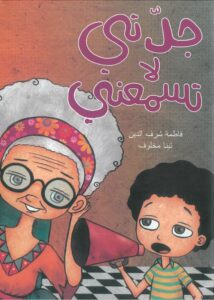 My Grandma Doesn’t Hear Me
My Grandma Doesn’t Hear Me 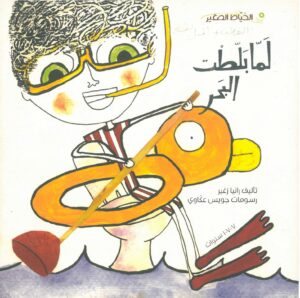 When I Paved the Sea
When I Paved the Sea 
